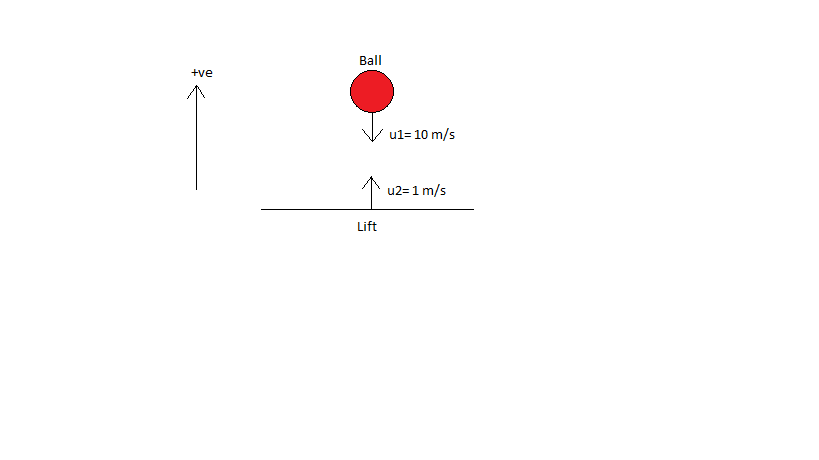
A ball falls from a height such that it strikes the floor of lift at 10 m/s. If lift is moving in the upward direction with a velocity 1 m/s, then velocity with which the ball rebounds after elastic collision will be
A. 11 m/s
B. 10 m/s
C. 12 m/s
D. 9 m/s
Answer
563.1k+ views
Hint: Two particles are moving in the same direction in a straight line with velocities $u_1$ and $u_2$ respectively. Before the collision their velocity of approach will be $({u_1} - {u_2})$
After collision velocity of the first particle and second particle are $v_1$ and $v_2$ respectively. Therefore, velocity of separation will be $({v_2} - {v_1})$.
Coefficient of restitution is the ratio of relative velocity of separation after collision to relative velocity of approach before collision.
Coefficient of restitution, $e = \dfrac{{{v_2} - {v_1}}}{{{u_1} - {u_2}}}$
For, elastic collision, $e = 1$.
Complete step by step answer:
Let us consider ball as particle 1 and lift as particle 2.
See the diagram before collision:

Taking upward direction as positive,
Velocity of ball before collision, ${u_1} = - 10$m/s
Velocity of lift before collision, ${u_2} = 1$m/s
Now, we should consider the situation after the collision.
After collision lift will continue it’s motion 1m/s upwards and the ball will rebound with a velocity, say $v_2$ in upward direction.
So, Velocity of lift after collision, ${v_2} = 1$m/s
Velocity of ball after collision be ${v_1}$m/s (let)
As it is an elastic collision, then$e = 1$.
We know, $e = \dfrac{{{v_2} - {v_1}}}{{{u_1} - {u_2}}}$
Now, putting the values,
$1 = \dfrac{{1 - {v_1}}}{{ - 10 - 1}}$
$\implies 1 - {v_1} = - 11$
$\therefore {v_1} = 11 + 1 = 12$m/s
So, Ball rebounds with 12m/s velocity upwards after elastic collision.
So, the correct answer is “Option C”.
Note:
We can take $e = 1$, when the collision is elastic. We can’t take $e = 1$for inelastic or partially elastic collision. For, perfectly inelastic collision, $e = 0$and for partially elastic collision $0 < e < 1$.
After collision velocity of the first particle and second particle are $v_1$ and $v_2$ respectively. Therefore, velocity of separation will be $({v_2} - {v_1})$.
Coefficient of restitution is the ratio of relative velocity of separation after collision to relative velocity of approach before collision.
Coefficient of restitution, $e = \dfrac{{{v_2} - {v_1}}}{{{u_1} - {u_2}}}$
For, elastic collision, $e = 1$.
Complete step by step answer:
Let us consider ball as particle 1 and lift as particle 2.
See the diagram before collision:

Taking upward direction as positive,
Velocity of ball before collision, ${u_1} = - 10$m/s
Velocity of lift before collision, ${u_2} = 1$m/s
Now, we should consider the situation after the collision.
After collision lift will continue it’s motion 1m/s upwards and the ball will rebound with a velocity, say $v_2$ in upward direction.
So, Velocity of lift after collision, ${v_2} = 1$m/s
Velocity of ball after collision be ${v_1}$m/s (let)
As it is an elastic collision, then$e = 1$.
We know, $e = \dfrac{{{v_2} - {v_1}}}{{{u_1} - {u_2}}}$
Now, putting the values,
$1 = \dfrac{{1 - {v_1}}}{{ - 10 - 1}}$
$\implies 1 - {v_1} = - 11$
$\therefore {v_1} = 11 + 1 = 12$m/s
So, Ball rebounds with 12m/s velocity upwards after elastic collision.
So, the correct answer is “Option C”.
Note:
We can take $e = 1$, when the collision is elastic. We can’t take $e = 1$for inelastic or partially elastic collision. For, perfectly inelastic collision, $e = 0$and for partially elastic collision $0 < e < 1$.
Recently Updated Pages
Master Class 12 Business Studies: Engaging Questions & Answers for Success

Master Class 12 Economics: Engaging Questions & Answers for Success

Master Class 12 English: Engaging Questions & Answers for Success

Master Class 12 Maths: Engaging Questions & Answers for Success

Master Class 12 Social Science: Engaging Questions & Answers for Success

Master Class 12 Chemistry: Engaging Questions & Answers for Success

Trending doubts
What is meant by exothermic and endothermic reactions class 11 chemistry CBSE

Which animal has three hearts class 11 biology CBSE

10 examples of friction in our daily life

One Metric ton is equal to kg A 10000 B 1000 C 100 class 11 physics CBSE

1 Quintal is equal to a 110 kg b 10 kg c 100kg d 1000 class 11 physics CBSE

Difference Between Prokaryotic Cells and Eukaryotic Cells




